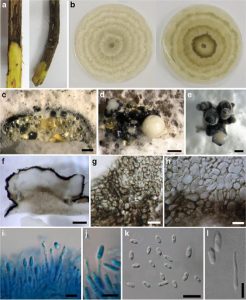Diaporthe tectonae Doilom, A.J. Dissanayake & K.D. Hyde, sp. nov., Index Fungorum number: IF551976
Etymology: Name refers to the host genus Tectona on which the fungus was collected.
Holotype: MFLU 15–3535 (dry culture)
Associated with branch and twig dieback lesions on T. grandis. Sexual morph: Undetermined. Asexual morph: on PDA, Conidiomata (460–)725–820(−1385) μm×(500–)900– 1035(−2075) μm (x = 773 × 918 μm, n = 25), pycnidial, scattered or aggregated, black, deeply embedded in media becoming erumpent at maturity, subglobose or variable in shape, with an elongated black neck, with conidial mass; initially hyaline to yellowish, becoming white to cream conidial droplets exuding from central ostioles after 20 days in light at 25 °C; pycnidial wall composed of a textura angularis, comprising of two cell layers, outer layer; black to brown, thickwalled, inner layer; hyaline, thin-walled. Conidiophores 11– 18 × 1–2 μm, hyaline, branched to unbranched, cylindrical, septate, smooth, occurring in dense clusters, straight or slightly curved, tapering towards the apex, wider at base. Conidiogenous cells 1.5–5.2× 0.9–1.7μm, phialidic, cylindrical, terminal, with slight tapering towards apex, 0.5–1 μm diam. Alpha conidia (4–)5.5–6(−6.8) μm×2–2.9 μm (x = 5.5× 2.6μm, n=30), with 1–2-guttulate, mostly bi-guttulate, hyaline, oblong to ellipsoid, apex bluntly rounded, base obtuse to subtruncate, smooth. Beta conidia 10–13.5 × 1.3– 1.7μm (x = 12×1.5μm, n =10), aseptate, cylindrical, flexuous, hamate, apex rounded, base subtruncate, hyaline, rare, smooth. Gamma conidia (7–)8–9(−10.6) × 1.3–2.1μm (x = 8.5 × 1.8 μm, n = 30), aseptate, hyaline, smooth, ellipsoid– fusoid, apex acutely rounded, base subtruncate.
Culture characteristics: Pure culture was isolated by subbing hyphal tips growing from surface sterilized diseased material. Colonies on PDA reaching 58–90 mmdiam. after 4 days in the dark at 25 °C, (x = 78, n =5), crenated or lobate, with concentric rings of dense and sparse hyphae, irregular margin, flat or effuse alternate to fluffy aerial, medium dense, after 10 days white (4A1) from above, from below olive brown (4D3) at concentric rings, reaching the edge of the Petri-dish after 4–10 days.
Habitat: Associated with branch and twig dieback lesions of T. grandis (Doilom et al. 2017).
Known distribution: Thailand (Doilom et al. 2017).
Material examined: THAILAND, Phayao Province, Chun District, Hong Hin Subdistrict, on dieback lesion of T. grandis twig, 23 November 2012, M. Doilom & J. Roux, (MFLU 15– 3535, holotype (dry–culture)), ex-type living culture MFLUCC 12–0777, MKT 090/1, ICMP 21170, GenBank Accession No: CAL: KU749345, ITS: KU712430, TEF1: KU749359, TUB: KU743977; ibid. with MFLUCC 12–0777, (MFLU 15–3536, paratype) ex-paratype living culture MFLUCC 12–0782, MKT 091/3, ICMP 21171, GenBank Accession No: CAL: KU749346, ITS: KU712431, TEF1: KU749360, TUB: KU743978; Chiang Rai Province, Mae Chan District, on dieback lesion of T. grandis branch, 3 March 2013, M. Doilom, (MFLU 15–3428 (dry–culture)), living culture MFLUCC 13– 0460, MKT 106/5, GenBank Accession No: CAL: KU749347, ITS: KU712432, TEF1: KU749361, TUB: KU743979; Chiang Rai Province, Muang District, Mae Fah Luang University campus grounds, on dieback lesion of T. grandis twig, 19 March 2013, M. Doilom, living culture MFLUCC 13–0476, MKT 115/2, GenBank Accession No: CAL: KU749348, ITS: KU712433, TEF1: KU749362, TUB: KU743980; Chiang Rai Province, Muang District, Doi Lan Subdistrict, on dieback lesion of T. grandis twig, 14 June 2014, M. Doilom & S. Yachareon, living culture MFLUCC 14–1132, MKT 163/2, GenBank Accession No: CAL: KU749349, ITS: KU712434, TEF1: KU749363, TUB: KU743981; ibid. with MFLUCC14– 1132, living culture MFLUCC 14–1134,MKT165/1, GenBank Accession No: CAL: KU749350, ITS: KU712435, TEF1: KU749364, TUB: KU743982; Chiang Rai Province, Mae Suai District, Mae Lao garden, on dieback lesion of T. grandis twig, 5 July 2014, M. Doilom, living culture MFLUCC 14– 1135, MKT 167/3, GenBank Accession No: CAL: KU749351, ITS: KU712436, TUB: KU743983; ibid. with MFLUCC 14–1135, living culture MFLUCC 14–1138, MKT
169/4, GenBank Accession No: CAL: KU749352, ITS: KU712437, TEF1: KU749365, TUB: KU743984; ibid. with MFLUCC 14–1135, living culture MFLUCC 14–1139, MKT 169/6, GenBank Accession No: CAL: KU749353, ITS: KU712438, TEF1: KU749366, TUB: KU743985.
Notes: Diaporthe tectonae is a close relative to D. tulliensis based on multi gene phylogenetic analysis. Diaporthe tulliensis was described from a culture isolated from a rotting stem end of a Theobroma cacao pod, and the association was not determined (i.e. pathogen, endophyte or saprophyte). It would seem unlikely that these two collections are conspecific, given the differences in host and distribution. In addition there are morphological variations. For instance, the outer layer of the conidioma walls of D. tectonae are black to brown textura angularis, but darker yellowish brown textura epidermoidea in D. tulliensis. The beta conidia of our collection are shorter and slightly wider (10–13.5× 1.3– 1.7 versus 25–30× 1.0–1.5μm) than those reported by Crous et al. (2015) for the holotype. Therefore despite the two collections (from Theobroma cacao and T. grandis) evidently being closely related, they represent distinct species.
FIG: Diaporthe tectonae (MFLU 15–3535, holotype). a Dieback lesions. b Colony on PDA after 10 days (above and below views). c–e Conidiomata with conidia mass sporulating on PDA after 1 month. f Section through conidioma. g Outer conidiomatal wall. h Peridium. i, j Conidiogenous cells. k Alpha conidia. l Beta and gamma conidia. Notes: g, h Stained in lactophenol cotton blue. Scale bars: c, d = 1000μm, e = 500μm, f = 300μm, g, h, j, k = 10μm, i, l = 5μm

